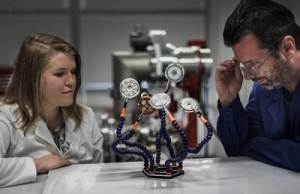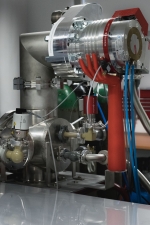Metallic layers with high entropy are formed in NCBJ
01-09-2022
Aluminum, titanium, nickel, niobium and tungsten – as many as five elements make up the high-entropy layers just produced at the National Center for Nuclear Research. Their production means that the center in Świerk joined the research on coatings considered to be one of the most innovative in contemporary surface engineering.
In recent years, materials science has focused more and more on coating materials with layers of multicomponent alloys with high entropy. It is so for a reason: compared to conventional alloys, these alloys are characterized by significantly better physical and chemical properties. The National Center for Nuclear Research (NCBJ) in Świerk has now joined this innovative research stream: the first five-component, high-entropy layer Was produced in the local Plasma Surface Engineering Laboratory. A team of NCBJ scientists described their achievement in the journal Surface and Coatings Technology. Pulse magnetron sputtering Was used in Świerk to create a new metallic layer. Contrary to the name suggesting the exoticism, magnetrons are quite popular devices: they are responsible, inter alia for generating microwaves in microwave ovens. Plasma surface engineering takes advantage of the fact that the glow discharge in the magnetrons strongly ionizes the neutral gas present in the vacuum chamber of the device (usually non-reactive argon). The resulting plasma effectively interacts with the starting materials at the cathode. The components sprayed by the plasma gradually settle on the target objects placed in the vacuum chamber, allowing precise control of the composition, structure and thickness of the forming layers.
„In our devices, we generate plasma in pulse-changing conditions. This mode of operation allows us to produce coatings from multicomponent non-equilibrium alloys with high entropy, i. e. alloys whose components would not combine in a similar way under typical thermodynamic conditions. The non-equilibrium structural state that characterizes these materials can be used to later shape the nanostructure of the target material and, consequently, to give it specific properties”, says PhD. Eng. Katarzyna Nowakowska-Langier, prof. NCBJ.
Conventional alloys are dominated by one or two elements and any additives, if any, appear in trace amounts. High-entropy Alloys (HEA) have a different structure: they consist of at least four elements with similar concentrations, in practice ranging from 5 to 35%.
„Light metal alloys are very popular in industry, especially in the automotive and aviation industries. So we designed a cover made of aluminum and titanium, which in order to improve the strength and thermal parameters we supplemented with nickel, niobium and tungsten. Proper preparation of the starting samples proved to be critical, so as to ensure the planned proportions of metals despite the use of only one magnetron. At the same time, we had to ensure the elimination of potential contaminants that would lower the parameters of the created layers”, explains MSc. Grzegorz Witold Strzelecki, PhD. student at NCBJ.
Research on pulsed magnetron sputtering has been developed in Świerk for several years. The Laboratory of Plasma Surface Engineering operating here, established by the National Science Center at the Department of Plasma and Ion Technologies, works in close cooperation with the Faculty of Materials Science and Engineering of the Warsaw University of Technology (WIM PW), the Institute of Physics of the Polish Academy of Sciences and the NOMATEN Center of Excellence. The samples covered with new high-entropy layers were tested in the laboratories of these institutions. All analyzes confirmed that the produced coatings have the composition, structure and thickness in accordance with the originally assumed parameters.
Objects subjected to magnetron sputtering, despite being exposed to plasma, do not heat up to high temperatures. Therefore, five-component NCBJ layers can be applied to various types of substrates, even polymeric ones.
Light alloys with high entropy are considered to be particularly difficult to produce, due to the fact that elements such as titanium and aluminum easily form metallic phases, considered undesirable here. The current achievement of NCBJ scientists proves that the initiated direction of research on layered materials made of multi-component alloys has a great development potential in Świerk.
SCIENCE PUBLICATIONS:
„Multi-component low and high entropy metallic coatings synthesized by pulsed magnetron sputtering” G. W. Strzelecki, K. Nowakowska-Langier, K. Mulewska, M. Zieliński, A. Kosińska, S Okrasa, M. Wilczopolska, R. Chodun, B. Wicher, R. Mirowski, K. Zdunek
Surface and Coatings Technology 446, 128802 (2022)
DOI:https: //doi. org/10.1016/j. surfcoat. 2022.128802
ILLUSTRATIONS:
Photo 1. Magdalena Wilczopolska and Grzegorz Witold Strzelecki, NCBJ PhD. students, present cathodes with elements used in research on the production of multi-component layers with high entropy. (Source: NCBJ / Katarzyna Nowakowska-Langier)
https: //www. ncbj. gov. pl/sites/default/files/field/image/fot1.jpg
Photo 2. Equipment for magnetron sputtering at the Laboratory of Plasma Surface Engineering at the National Center for Nuclear Research in Świerk. (Source: NCBJ / Katarzyna Nowakowska-Langier)
https: //www. ncbj. gov. pl/sites/default/files/field/image/fot2b. jpg






